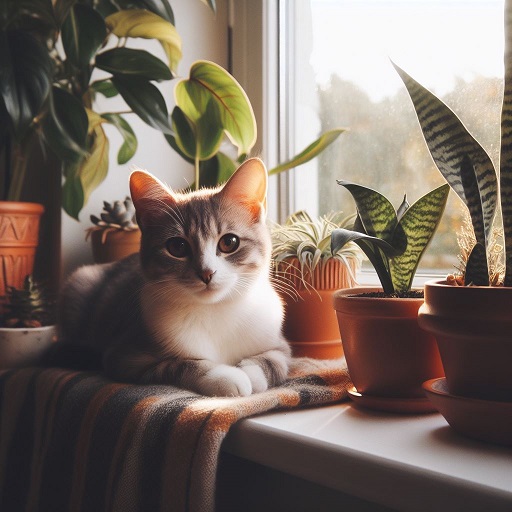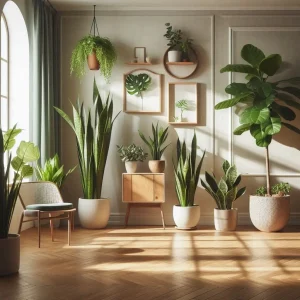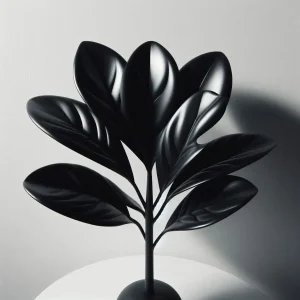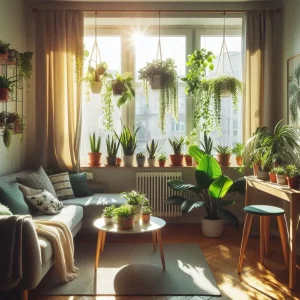The cats are members from carnivorous animals. They like to eat meal, and something’s like that, but in other way they also like to chew, nibble and swallow flowers or even eat indoor and outdoor plants. This is a big deal and very important, because there are plants out there which is toxic or poisoned that could be harm the cats. It could be reason of there poisoned and sicknesses such as: upset stomach, constipation or even worst like death, because of that plant was poisoned and toxic. You as a cat owner should identify which plants of yours or the plants you are about to buy are not be dangerous or houseplants safe for cats. You better to know the kind of plants that are around your house to make your pets to avoid from them. If you are a cat owner or just to be here for specifics or more information about what sort of plants could be dangerous for cats, then you are in the right place. We are here to give you all, that kind of information. Anyhow if you are one of those groups, then you should proceed and keep reading this essay to find it out about unsafe plants for cats and some top plants that are toxic or poisoned for cats and the must to avoid, just take a look of our list.
List of Poisonous Plants for Cats
Page Contents
Toggle1.Lily
Lilium is another name for the lily which is a flowering plant that is growing from bulbs, all of them with large noticeable flowers, and it is from herbaceous species. Lilies also do matter in literature and culture in much of the world. The thing is so incredible for pollinators, attracting with its large colorful flowers and tasteful nectar. Lilies got large petals that can be yellow, white, orange, red, purple or pink in color or some of them have freckles.

Lilies also associated as symbol of love, devotion, purity, and fertility. Lily has some personality traits, including being talkative, curious, independent, impatient, and unempathetic. All personalities have come from the story. The meaning of lily in English is “pure” and also symbolic of innocence. Lily is a popular plant in around of the world. This plant is unsafe for cats. Calla lilies and peace lilies both of them contain crystals of calcium oxalates which are don’t dissolve in water, if a cat nibbles, chews or bites the plant, the things that can cause of damaging, names are crystals and that will released and straight bother the mouth, throat and tongue. This beautiful love plant can be extremely dangerous for the cats then do not let gorgeous lily to delude you with her beauty and symbolic of innocence thing, it could be the guilty number one.
2.Daffodils
These sunshine_yellow flowers emerge at winter’s end to lift our spirits. It is also available in color of orange and white. This plant, which is flower’s family in the ancient Greeks associated with self-love, and in literature, the daffodil is often used as a symbol of unrequited love and hope daffodil do grow in full sun but will tolerate light shade. It could be grown in holders, in boundaries and in lawns naturally.

A daffodil field can bloom for decades. Chinese has a traditional thing about this plant, that is if daffodil blooms in Chinese New Year it would bring the luck. Daffodils contain sap that’s often poisonous to other plans. The daffodil’s personality symbolic associated with compassionate, artistic, independent, loving, sensitive, dreamy, fearful, impossible and romantic. Another name for a daffodil is “Narcissus” and “Jonquil.” The place where is famous for daffodils is Northern Ireland. Daffodils live for three to five years. Additionally daffodils are symbols of rebirth and hope. This plant can be like a girl’s name. Daffodils are terribly poisonous for cats. All parts of the daffodil contain a toxic chemical, lycorine. It can cause of dangerous conditions such as abnormal heart rhythms or breathing problems in cats. Cats owners should keep their pets staying away from daffodils.
3.Tulip
This kind of flower is large and has different colors, normally red, white, yellow and pink. Tulips are known as a symbol of perfect and deep love. It is a wild flower which grown in central Asia. Tulips are also known as national flower of Iran and Turkey. Tulips growing not stopped even after they have been cut. Tulips need full sun to grow. Every last one of the tulip’s colors has their own meaning: pink tulips symbolic of happiness and confidence.
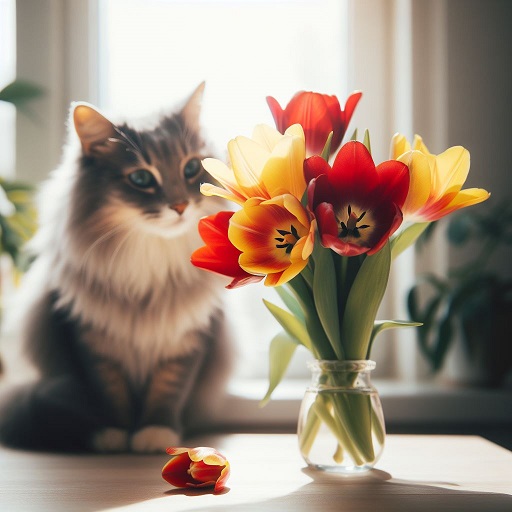
Purple tulips symbolic of royalty. Yellow tulips symbolic of cheerful thoughts. White tulips are symbols of forgiveness. Tulips known as their colors and gorgeous shape, and blue is one of the colors that is the rarest color of tulips. The Netherlands is the country which is rich in tulips. Tulips are toxic and poisonous to cats, because they contain an alkaloid and glycoside mixture as well as allergenic lactones. Many parts of tulip can harm cats and make them sick, and it could be cause of ill from the bulbs to the stems and the leaves. Tulip is one of the members of lily’s family then tulips have lily’s killing ability.
4.Rhododendron
In the Pacific, tha Northeast, the Northwest, the upper south and Northern California is the best place that rhododendron grows. The rhododendron plant is dangerous and toxic if ingested to human and animals. That is probably why rhododendron knowns as symbolic of caution and danger. It is possible, it brings you skin irritation if even touch and have physical contact with the plant.

The negative effects of rhododendron including vomiting, diarrhea, abdominal pain, weakness, depression, cardiac, arrhythmias, hypotension, shock, cardiopulmonary, arrest, pulmonary edema, dyspnea, seizures and the worst of all, death. They naturally prefer an open soil mixture. The biggest rhododendron was discovered in India in 1993, and that was twenty meters. Rhododendron meaning is “red tree.” Its symbolic meaning is warning and beauty. Another name for a rhododendron is Azalea which is also rhododendrons. Inside or outside of azaleas and rhododendrons are poisonous and toxic to cats. The leaves, the stem and flower of it are extremely toxic and poisonous for your pet cats, then be careful and don’t let your cat to get close to it and ingest it.
5.Cyclamen
In the family of primulaceae which is species of perennial flowering plants. Cyclamen blooms for up to three months. It is surviving in the severest weather. Cyclamen dies into the summer and regrows quickly each fall. Cyclamen needs a bright and cool spot to thrive. The red one of the cyclamen can purify the air.

Nine months do it take for a cyclamen to grow after sowing. The cyclamen’s Chinese name meaning is “the guest comes from the fairyland.” The best place to plant cyclamen is around the base of mature shrubs and trees. Its name came from Greek word “Kuklaminos” which means”circle”. Cyclamen is the symbol of prosperity and also fertility. Another name for a cyclamen is Alpine violet, Persian violet and showbread. Cyclamen contains terpenoid saponins that is harmful to your pet cat and it could be the cause of salivation, vomiting, diarrhea. Cyclamen also contains irritating saponins, and when cats ingest or chew any part of the cyclamen particularly its root or tubers, it can be followed by vomiting and diarrhea. This plant should not be kept in a cat owner’s home.
6.English ivy
Another name for English ivy is called branching ivy, glacier ivy, needlepoint ivy, sweetheart ivy and California ivy. In the family of Araliaceae, English ivy is a plant which is flowering plant. The benefit of this plant that we could mention it is as a houseplant, it may purify the air. English ivy needs bright light, but not direct sun and also needs once per week watering to grow, it grows September to November.
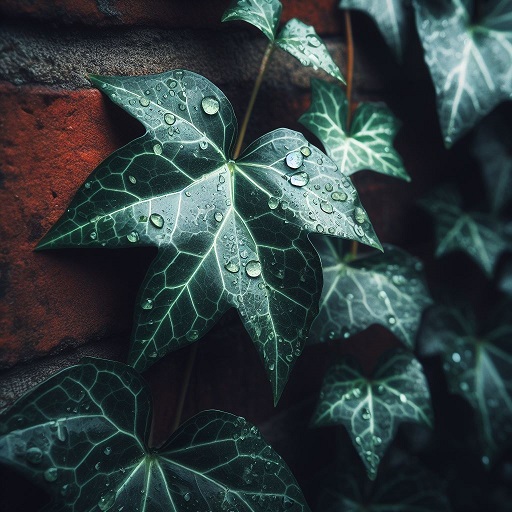
The leaves and fruit of English ivy are toxic to human and livestock. English ivy grows about 50 cm to 70 cm per year. English ivy grows about six to eight inches tall. Ten years or longer it does take for English ivy to bloom. English ivy contains triterpenoid saponins, and if ingested by cats, it can cause of vomiting, abdominal pain, hyper salivation and diarrhea. These plants are toxic and poisonous to cats and other pets and animals. It is not a good plant to keep indoor or outdoor for cats.
7.Sago palm
Or cycas revolute is a species of gymnosperm in the family cycadaceae. Sago pearls came from the sago palm. Sago palm usually find as an outdoor plant, it is not safe for cats then you need to be careful about that. Sago palm is toxic to animals and even human, after contact with this plant you should wash your hands. Sago palm is a good plant to purify the air. It is considered a bad luck plant.
They survive for a long time, probably because of animals do not eat them, they are having a life span of over 200 years. All parts of sago palm are toxic and poisonous that is not good to cats. Sago palm grown outdoors need part shade to prevent their leaves from burning and they need water every five to seven days. Sago palm belongs to the Indonesian archipelago, sago palm forests are particularly extensive on seran Island. Sago palm considered as a symbol of twin concepts of germination of plants and generation of humans. The entire of sago palms is toxic and poisonous to cats including the seeds and fronds. It is not appropriate to keep it indoor and outdoor, because it is dangerous to cats.
8. Castor bean
Ricinus communist, the castor bean an oil plant, is a species of perennial flowering plant in the spurge family. If castor beans are chewed and swallowed the released ricin that can cause injury. It is not dangerous by physical contact with it or even touches it, but if ingested parts of the plant such as the leaves, the seeds, which contain ricin, it is going to be harmful. Castor bean uses as treatment of antiviral, burns, ear and head ache, malaria and night blindness while the stems are used to treat cancer and hypoglycemia.

The reason why castor bean called castor is that the Greek word replaced the native latin word for “beaver”(fiber). The seed of the castor bean only toxic if the outer shell is broken or chewed. Castor bean is toxic, poisonous, and it can be very dangerous to cats. The level of toxicity depends on how much is consumed. Castor bean can cause of stomachs, discomfort, cramping, nausea, and faintness. This plant has ricin, one of the most potent toxins in the natural world. Protect yourself and your pet from that toxicity thing. Cat owners should have taken caution in keeping their curious cat away from the castor bean.
In conclusion
In light of this evidence, it is crystal clear that the cats need to protect from the plants which are dangerous toxic and poisonous to them, if you like to keep plants indoor or outdoor of the place that you are living you need to make sure the plants you want to pick, are not going to harm to your pet cats. Don’t solely look at the plants that look beautiful, like to take look at this one, it is so pretty or my neighbors are keeping this one in their houses, the first thing that you should consider that the plant is not poisonous or toxic to cats. Check out the plants outdoor if you are about to go out with your cat or in your yard and garden don’t keep these plants that we are mentioned and which are not harmless to cats. This is the list of outdoor and indoor plants that are not dangerous to the cats, and some of them even are good for them: Bird’s nest fern, African violet, Succulents, ponytail palm, Calathea orbifolia, parlor palm, spider plant, Rattlesnake plant, catnip, silver vine, cat thyme, Venus Flytrap. Keep an eye on these cute and beautiful creatures.

